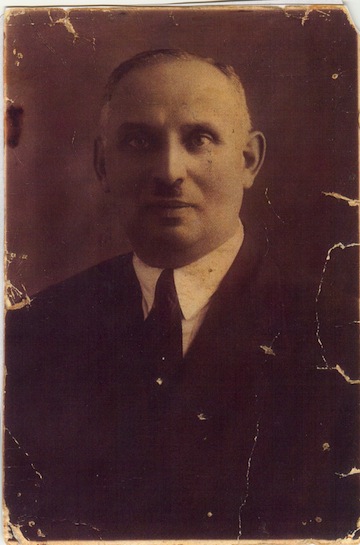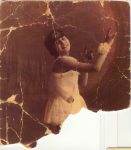The author’s maternal aunt, Sara Basson (at age 23). (photo from Libby Simon)
It was the long, cold winter nights in Winnipeg that made me do it. With my husband working late and a preschooler asleep in her room keeping me housebound, what else could I do? I finally tackled the onerous task of sorting seemingly hundreds of musty, dusty family photos that lay scattered inside battered cardboard boxes saved by my parents, their lives obviously too busy living the moments.
Who were these people in these tattered and torn brown photos? Some, I had been told, were Aunt Lorna or Cousin Sylvia. Others were total strangers. The clothing and hairstyles against an unfamiliar backdrop told of another time and place in history. Places I had never seen nor been, yet vague memories from childhood floated in my mind. Some pictures had writing on the back in a foreign language I could not read or understand. Nonetheless, I carted these decaying remnants along with all the important household belongings wherever we moved. Why had I not discarded them?
I now painstakingly placed these memories of bits and bytes under protective sheets in photo albums, one by one. Organizing them in some fashion was just too daunting a task. For the moment, preserving them was the goal – for whom I did not know. That question wouldn’t be answered until many years later, when I received a letter that launched an unexpected personal journey.
Bold, black type on unfamiliar letterhead demanded my attention – Lois Feinberg, Financial Consultant, Hollywood, Florida. I was about to toss out what I thought was spam sent by snail mail when one short sentence leaped out at me: “I’m your second cousin on your mother’s side,” it read. “My grandmother and your grandfather were siblings.”
Maybe it was more scam than spam but I had to pay attention. What did she want? Credit card numbers? Bank account numbers? Transfer a million dollars out of some remote African country? I read further with guarded skepticism.
“In the process of my genealogical research,” she wrote, “I found our mutual cousin, Sylvia, who gave me your contact information. I would like the names and birth dates of your family in order to register this information with the Yad Vashem in Israel.”
Yad Vashem. I knew it as the memorial centre for the murdered six million Jews and a symbol of the ongoing confrontation with the rupture of families engendered by the Holocaust. My doubts began to dissipate as the letter took on a flavour of authenticity. After confirming its legitimacy with Sylvia, I provided Lois with the information she requested. I did not pursue further personal contact, however, because, frankly, I have not been blessed, or cursed, with the need to search out relatives who could be more of a blemish than a blossom on my family tree.
But things were about to change.
Circumstances arose the next winter that would take my husband and me to Florida. I contacted Lois and invited her for lunch. When I greeted this pretty, dark-eyed, dark-haired lady, we hugged each other warmly. She appeared similar in age, slim, well-dressed and refined in manner. Lois had been a teacher turned financial consultant, divorced from her doctor husband, with two grown children.
“I discovered two other cousins who live in Florida whose grandparents are also siblings of our grandparents,” she said. I was stunned. Two more family members – right here!

“I’ll arrange a brunch at my home so you can meet them,” she promised with a smile. And, true to her word, the cousins all gathered at her home the following week.
A strange mix of emotions coursed through me as the past and present began to meld. Until recently, we were totally unaware of one another’s existence. Suddenly, we had a common thread tying us together – our grandparents.
Lois told me that the grandparent siblings, including my maternal grandfather, had all come to the United States in the 1930s to escape Hitler’s rise to power, but he was the only one sent back, because of a leg deformity. Not from disease, mind you, but the result of an accident. In the course of operating his paper company business, a heavy object had fallen on his leg yet he continued to run a successful business. I was told he and several other relatives were among the six million Jews murdered in the Holocaust.
Like a seismic jolt of lightning, the brown pictures flashed across my mind. For the first time, my grandfather became more than a lifeless face on a faded old photo. Sadness and anger pulsed through me. He was my mother’s father – a living, breathing person whose life had been cut short. Not by a natural disaster like a tsunami, a flood or earthquake, but by a human-made catastrophe, the Holocaust. Nature’s cataclysmic events kill randomly but humans ravaged and murdered with deliberation and purpose. While we had been spared the agony of their deaths, history had changed the lives of those who lived, splintering family shards across the globe, many of which will never be repaired.
Yet it was heart-warming to meet Marty, the supervisor IRS lawyer in south Florida; Arnie, a retired businessman; and their wives. After a four-hour brunch came to a pleasant end, plans were discussed for “The Brunch” next winter, ensuring a future for this fractured family.
These images gradually transcended time and geography and were now transplanted into my world in the 21st century. They were channeled from a dismal and distant past to live again in the present. In fact, in April 2012, I learned the names of six of my maternal relatives who were murdered in the Holocaust. My Israeli family had listed their names at Yad Vashem in Israel. I have now added them to Winnipeg’s Holocaust memorial on the grounds of the Manitoba Legislature to further ensure they will never be forgotten.
The exciting promise of a journey of discovery still lies ahead, as traces of life continue to sprout new branches on this family tree – blemish or blossom. I knew now for whom these pictures were preserved. I preserved them for me and for future generations of Jewish history. L’dor v’dor.
Libby Simon, MSW, worked in child welfare services prior to joining the Child Guidance Clinic in Winnipeg as a school social worker and parent educator for 20 years. Also a freelance writer, her writing has appeared in Canada, the United States, and internationally, in such outlets as Canadian Living, CBC, Winnipeg Free Press, PsychCentral and Cardus, a Canadian research and educational public policy think tank. She wrote this piece with International Holocaust Remembrance Day (Jan. 27) in mind.

